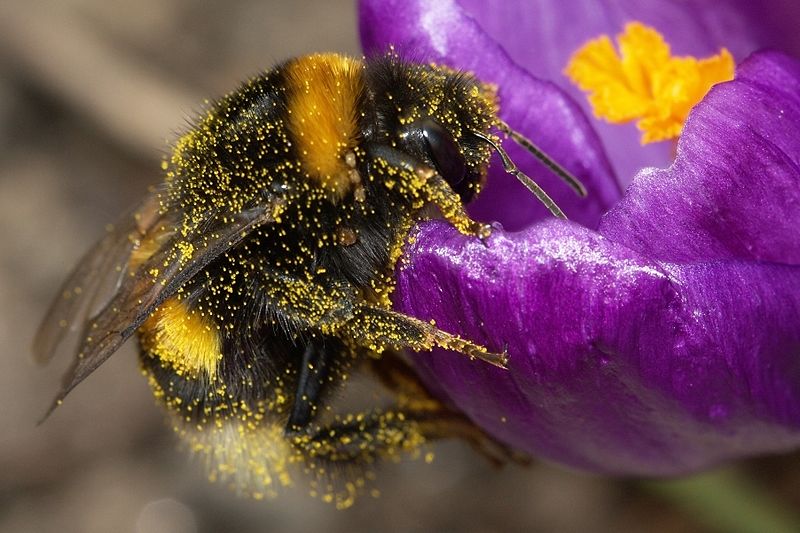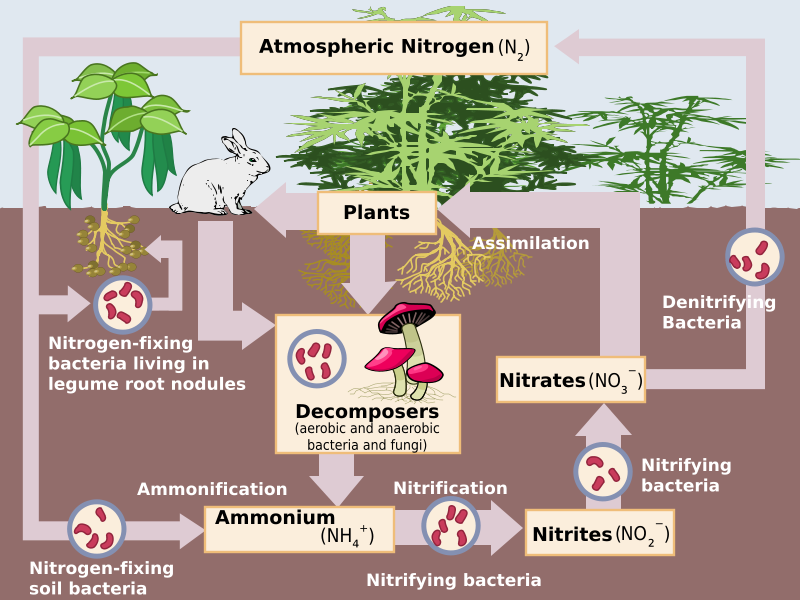Interactions
Bees
Bumblebees
and native bees are a big component in the health of the
Miniature Lupine.
By the process of pollination, bees are accountable for the
production and health of two-thirds of the world’s crop
production and 70% of angiosperms (Xerces
2013).
Pollination consists of bees taking pollen and using the
nutritional parts to feed its young (MSU
2013). Once finished, it
results in moving pollen from one plant to the next creating the
reproduction of new seeds and fruits of multiple plants (Xerces
2013). This mutualistic relationship between
Bumblebees, native bees and the Lupinus bicolor help the process
of reproduction for the plant and give a valuable nutritional
food source for their developing offspring
(MSU 2013). Some specific examples of
pollinators would be the
Bald-face Hornet and the Flower
Fly. When the
plant is full of pollen and is ready to be pollenated, the
colors of the petals are a white/light blue color (SPLASH
2013). Once
pollination occurs within the organism, the petals change to a
violet/dark blue color signaling to pollinators that there is no
more pollen left (SPLASH 2013).
Although L. bicolor interacts
with pollinators, they don’t solely rely on pollination for reproduction. Though bees can help with pollinating, the
Lupinus bicolor self-fertilizes after and can still
reproduce without their help. Check out the
Reproduction page for more information.
Image 11 (above). Showing interaction of Bumble bee and a flower as it is pollinating.
Humming Birds and Butterflies
Similar to the bee’s relationship to the Miniature Lupine, hummingbirds and
butterflies use its nectar for a nutritional food source. Not one
specific species of hummingbirds use the nectar of Lupinus bicolor,
but a variety of species, which means that it benefits multiple
species from its nectar alone (Calflora
2013). Examples of these species would be the
Hummingbird Clearwing Moth and the Fall
webworm. In relation specific to butterflies,
the
Arrowhead Blue butterfly uses Lupinus bicolor as hosts for the
caterpillar stage to gather nutrients, grow, and morph into a
butterfly (Moths and Butterflies 2013).
 California Poppy
California Poppy
The Miniature Lupine is frequently found with another
organism called
Eschsholzia californica, more commonly known as the California
Poppy. Both of the plants have similar growing methods and live
simultaneously without a problem. Not to mention, the lavender color
of the Miniature Lupine and the vibrant orange color of the Poppy combine to
create a stunning view.
Image 12. Lupinus bicolor in co-habitation with a variety of the Eschosholzia genus. Photo used with permission from and taken by Mark Skinner.
Nitrogen-Fixing Bacteria
Nitrogen is one of the most abundant
gasses on this earth but many plants struggle with being nitrogen
deprived. Why is this? It’s because most Nitrogen in the universe is
comprised of a specific molecular structure, which is not useful
in plants (The Microbial World 2013). Since Nitrogen has the biggest influence in growth and
biomass productivity, it is an important element in the health and
strength of a plant. One way to solve this Nitrogen deficiency is a
process called Nitrogen Fixation shown in figure 13 (The
Microbial World 2013). This process occurs in
the root structures of the Lupinus bicolor in which it houses the
fixing bacteria. The bacteria take Nitrogen in gas form and make it
available to plants. Through this method, the bacteria are able to
convert those complex chemical structures into useful elements, such
as Nitrate and Ammonia (The Microbial World
2013). The products of Nitrogen fixation are used
to make proteins and amino acids to assist the growth of the plant.
Studies have been tested on the effects of the destructive gopher mounds and the ability of multiple plants to regain their health through Nitrogen Fixating bacteria. Interactions with gopher mounds can change multiple settings in the soil, which will eventually affect the species richness and colony abundance of each organism originally growing there (Canals et al. 2005). Gopher mounds are shown to disrupt 30% of the grasslands of California (Canals et al. 2005). With the stirring of nutrients in the soil from the gopher mounds, pools of inorganic Nitrogen is often found which affects various plant growth and Nitrogen uptake for each organism (Canals et al. 2005). In a recent study, scientists have found that there was a low uptake inorganic Nitrogen but compared to other species in the same environment, L. bicolor had a similar amount of Nitrogen in its system (Canals et al. 2005). Based on these results, it can be concluded that the Nitrogen in its system is a result of symbiotic Nitrogen fixation (Canals et al. 2005). Through symbiotic Nitrogen Fixation, a mutualistic relationship is formed between Nitrogen Fixing bacteria and the Lupinus bicolor where the bacteria is given organic Carbon and a place to live and Lupinus bicolor is given the fixed Nitrogen it needs to produce the necessary materials for growth.
Figure 13. Flow chart of the interactions of several organisms through the process of Nitrogen Fixation.
Go back to Reproduction or continue to Fun Facts.
